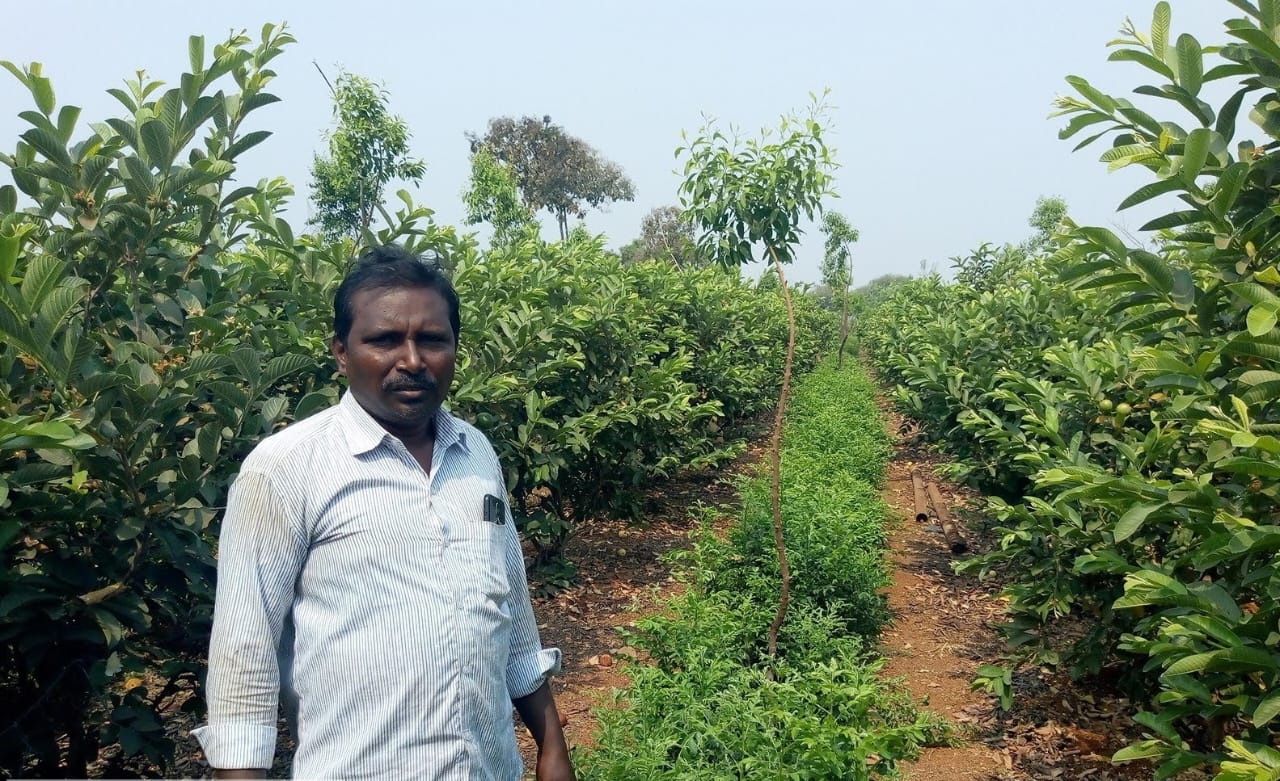Shri M Lakshmanna’s Journey to Natural Farming in Mudumala, Kurnool District, Andhra Pradesh

In the village of Mudumala, located in the Kurnool district of Andhra Pradesh, a farmer named Shri M Lakshmanna has become a shining example of how natural farming can transform lives. He has adopted innovative techniques in his 1.5 acres that have improved his livelihood and inspired others to adopt natural farming.
Struggles with Conventional Farming
Before 2019, Lakshmanna, like many farmers in his region, relied heavily on synthetic fertilizers and pesticides to cultivate his crops. Initially, these practices would increase his yields and income, but the results were disappointing over time. The costs of fertilizers and pesticides began to outweigh the profits, pushing him into severe financial distress. To sustain his farming operations, Lakshmanna borrowed heavily, accumulating debts of ₹6-7 lakhs from banks and relatives.
Despite these investments, he noticed a decline in soil fertility, which further reduced his crop yields. Adding to this, frequent exposure to chemical pesticides led to health issues for him and his family. The increasing debts and health left Lakshmanna searching for a solution that could bring him financial stability and improve his family’s well-being.
A New Beginning: Transition to Natural Farming


The turning point came in the year 2019 when the Centre for Sustainable Agriculture (CSA) staff introduced Lakshmanna to the principles of natural farming. They encouraged him to move away from conventional farming and adopt a multi-layer cropping model. This model involved cultivating a diverse range of crops on the same piece of land to optimize resource use, increase income, and improve soil health. The CSA team also emphasized the importance of growing organic vegetables for household consumption, which could contribute to better health for his family. With their guidance, Lakshmanna decided to make a bold shift to natural farming, despite the initial uncertainties and challenges.
Implementation of Natural Farming Practices

In October 2019, Lakshmanna began transforming his 1.5-acre farm into a natural farm. He planted 730 guava saplings as his main crop, along with 330 sandalwood trees for long-term income. He further diversified his farm by adding 2 lemon trees, 10 pomegranate trees, 2 coconut trees, 2 custard apple trees, 2 grapevines, 6 teakwood trees, 2 drumstick and curry leaf trees as intercrops and grew 10 varieties of vegetables for household consumption. To nourish his crops, he prepared 600 litres of Jeevamrutham (liquid bio-fertilizer) in a pit on his farm and applied it through drip irrigation every 15 days of interval. For additional plant growth, he used natural inputs like egg amino acids and fish amino acids. To control pests, he installed fruit fly traps and applied neem cake near the roots of his plants. For soil health, he practised mulching by spreading groundnut husk across his fields, which helped retain moisture and enhance soil fertility.

Marketing Innovations and Increased Income
Lakshmanna adopted innovative strategies to market his organic produce, especially for vegetables. Every Sunday, he set up a stall at the weekly market in his village with a banner mentioning “Naturally produced and freshly harvested vegetables”. Additionally, he used to sell his produce every Monday near the MRO office at the C Belagal mandal, Kurnool district.



By directly connecting with customers he managed to secure 15-20% higher prices compared to the standard market rate. The income generated from his natural farming practices not only helped him repay his debts but also brought financial stability to his family. Furthermore, consuming the organic vegetables grown on his farm significantly improved the health of his household members, proving that natural farming benefits both the farmer and the consumer.
Challenges and Lessons Learnt
The journey to natural farming was not without its challenges. The initial investment in setting up the multi-layer cropping model required effort and time, and the transition from conventional to natural farming practices needed patience. However, as a long-term benefit, Lakshmanna’s soil health improved, pest infestations were reduced, and yields were stabilized.
“Lakshmanna’s success showcases how multi-layer cropping can significantly enhance both income and soil health,” says M. Mareppa Secretary from Thungabadra FPO
Future Plans: Expanding the Horizon
Looking ahead, Lakshmanna has ambitious plans to further diversify his farm. He intends to rear six goats and ten native chicks, which would provide an additional source of income. Moreover, as the guava trees on his farm have completed their productive lifespan of five years, he plans to replace them with pomegranate trees, which he believes will offer higher returns in the future.
Conclusion

M. Lakshmanna’s journey from debt-ridden chemical farming to successful natural farming is evidence of the transformative power of sustainable agriculture. By adopting natural farming practices and innovative marketing strategies, he has not only achieved financial independence but also set an example for other farmers in his community to adopt natural farming. His story highlights the importance of natural farming in improving livelihoods, promoting health, and ensuring environmental sustainability.
Acknowledgement
I would like to sincerely thank M. Lakshmanna from Mudumala village for sharing his valuable experiences and insights about natural farming.
I also want to thank the team at CSA for their support and guidance in helping farmers transition to natural farming. Their efforts have made a big difference in the lives of farmers like Mr. Lakshmanna.
Finally, I appreciate the help of Mr Uday K Nagubandi who contributed to this case study, his assistance in compiling and formatting has made this story come to life.
Authored by Uday Kumar Besta, Natural Farming Coordinator, Kurnool, Andhra Pradesh, Centre for Sustainable Agriculture (CSA), January 2025

